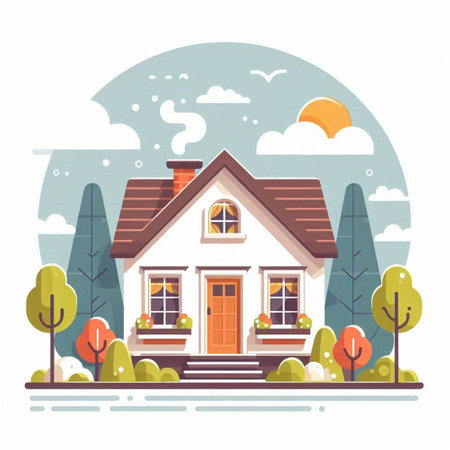Introduction to Smart Home Automation in the UK
Smart home automation has swiftly become a transformative force within British households, evolving from a futuristic concept to an accessible reality. By integrating digital technologies such as intelligent lighting, heating controls, and connected appliances, residents across England are discovering new ways to manage energy consumption more efficiently. The growing interest in smart home technology is not only driven by advancements in connectivity and user-friendly interfaces, but also by rising energy costs and heightened environmental awareness. Recognising these trends, the UK government has introduced several initiatives to encourage homeowners to adopt energy-saving solutions, such as the Smart Metering Implementation Programme and various grants for green home improvements. As a result, smart home adoption is accelerating nationwide, setting the stage for significant progress in energy conservation across urban flats in London, suburban homes in Manchester, and rural cottages in the Lake District alike.
Technology and Approaches for Energy Conservation
Smart home automation is rapidly transforming the way households across England manage and conserve energy. The integration of advanced technologies, tailored to the UK’s specific energy needs and environmental goals, plays a pivotal role in this shift. Below, we examine some of the most impactful smart home devices and approaches that are redefining energy efficiency in British homes.
Key Smart Home Devices
The adoption of smart thermostats, intelligent lighting systems, and connected appliances has become increasingly common in UK households. These devices offer not only convenience but also substantial potential for reducing energy consumption. Their functionality is enhanced by adapting to local weather patterns, variable tariffs, and user behaviours unique to the UK.
Comparison of Popular Smart Home Devices in England
| Device | Main Function | Adaptation to UK Energy Landscape |
|---|---|---|
| Smart Thermostats (e.g., Nest, Hive) | Automated temperature control based on occupancy and schedules | Integrates with British Gas and other suppliers; responds to fluctuating tariffs; supports government initiatives like the Green Homes Grant |
| Intelligent Lighting (e.g., Philips Hue) | Dimmable, remote-controlled lighting that adjusts to daylight levels | Syncs with the National Grid’s demand response signals; optimises usage during peak/off-peak hours |
| Connected Appliances (e.g., smart washing machines, fridges) | Remote scheduling and monitoring for optimal operation times | Can be programmed to run during off-peak electricity rates; some models track carbon intensity of grid electricity |
Energy Management Tailored to the UK
The UKs variable weather and evolving energy market require smart devices that can flexibly respond to changing conditions. For instance, many smart thermostats are now equipped with weather forecasting capabilities, allowing them to adjust heating schedules in anticipation of cold snaps or milder periods—crucial in a country known for its unpredictable climate. Similarly, smart lighting systems consider natural light availability, maximising daylight usage while minimising artificial lighting costs.
Integration with Renewable Energy Sources
An increasing number of British households are investing in solar panels and home battery storage. Smart home automation platforms seamlessly integrate these renewables into daily energy management routines. For example, connected appliances can be scheduled to operate when solar generation is at its peak, ensuring efficient self-consumption and further lowering reliance on the grid.
By leveraging these technologies and adaptive approaches, homeowners across England are not only reducing their carbon footprint but also gaining greater control over their energy expenditure—setting a precedent for sustainable living throughout the country.

3. Urban Households: A London Case Study
Retrofitting Smart Automation in a Central London Flat
In the heart of central London, where Victorian and Edwardian flats often present unique challenges for energy efficiency, one homeowner undertook a comprehensive smart home automation retrofit. The property, a two-bedroom flat in Marylebone, was equipped with an integrated system comprising smart thermostats, automated lighting, and real-time energy usage monitoring. This case provides a practical example of how urban dwellings can embrace technology to drive down both consumption and cost.
The Retrofit Challenge
Unlike new builds, retrofitting older properties in London comes with specific obstacles. Thick masonry walls and outdated wiring systems complicated the installation process. For instance, integrating smart thermostatic radiator valves required careful planning to avoid disturbing historic features. Additionally, wireless connectivity had to be optimised due to signal interference from dense neighbouring buildings.
Solutions Implemented
The homeowner selected a modular automation platform compatible with existing infrastructure, opting for battery-powered sensors where rewiring was impractical. Automated schedules were set up for heating and lighting based on occupancy patterns detected by motion sensors. Smart plugs and appliance monitors allowed precise control over high-consumption devices such as the immersion heater and tumble dryer.
Results and Insights
Within six months of installation, the household saw an average 18% reduction in electricity bills and improved comfort thanks to zone-based heating control. Notably, the system’s real-time feedback encouraged behavioural change—residents became more mindful about switching off appliances when not in use. However, initial costs and technical hurdles highlighted the importance of tailored solutions for period properties common across London.
4. Rural Homes: Advancements in Northumberland
While smart home automation is often associated with urban environments, rural areas such as Northumberland are increasingly embracing these technologies to address unique challenges. Unlike city dwellings, countryside homes frequently contend with unstable grid connections and the logistical difficulties of energy delivery. The following case study demonstrates how a Northumberland household leveraged smart automation to optimise their energy consumption and bolster sustainability.
Insights from a Countryside Home
The property, situated on the outskirts of Alnwick, faced regular power fluctuations and limited access to modern infrastructure. To overcome these limitations, the homeowners implemented a comprehensive smart automation system tailored for rural needs. This included:
- Solar panels integrated with battery storage for off-grid reliability
- Smart thermostats programmed to adapt heating schedules based on weather forecasts
- Automated lighting and appliance management to reduce waste
- Remote monitoring via smartphone, allowing the owners to manage consumption even when away
Addressing Unique Rural Needs
| Challenge | Smart Solution | Impact |
|---|---|---|
| Unstable grid connection | Battery storage & solar integration | Consistent power supply; reduced reliance on the grid |
| Inefficient heating systems | Smart thermostats & zoning | Lowered energy bills; improved comfort |
| Difficulties in manual monitoring | Remote control via app | Greater oversight; proactive adjustments possible |
Sustainability Outcomes
This approach resulted in an estimated 35% reduction in annual energy use, as well as increased resilience during outages—a frequent issue in rural Northumberland. The integration of localised renewable energy sources further aligned with the UK’s broader goals for carbon neutrality.
The case exemplifies how smart home automation can be adapted to meet the specific requirements of rural living, delivering tangible benefits both for residents and the environment.
5. Community Initiatives in Manchester
Collaborative Efforts for Smarter Living
Greater Manchester has emerged as a leading region in England for piloting community-driven smart home automation projects aimed at energy conservation. Local councils, such as Manchester City Council and Salford City Council, have joined forces with residents, housing associations, and technology partners to develop integrated solutions that maximise collective energy savings while fostering a sense of local ownership.
Pioneering Projects Across Neighbourhoods
One notable initiative is the ‘Smart Energy Greater Manchester’ project, which brings together hundreds of households across various boroughs. Through council-led workshops and neighbourhood forums, residents are introduced to intelligent thermostats, automated lighting systems, and real-time energy monitoring tools. These technologies are installed with support from local contractors, ensuring accessibility and inclusion for elderly or vulnerable residents. The collaborative approach enables communities to share data on usage patterns and best practices, creating an ecosystem where learning is continuous and collective progress measurable.
Local Impact and Broader Benefits
The outcomes from these collaborative ventures have been significant. On average, participating households have reduced their energy consumption by 15-20%, thanks to optimised heating schedules and automated devices that switch off appliances when not in use. Councils track aggregated data to identify trends and further tailor support for each neighbourhood, while residents benefit from lower utility bills and a stronger community network. Beyond individual homes, these initiatives contribute to Greater Manchester’s broader ambitions for carbon reduction and sustainable urban living—demonstrating how coordinated action at the local level can deliver impactful change across England.
6. Challenges, Lessons Learned, and Future Prospects
Barriers to Wider Adoption
Despite the promising results from smart home automation case studies across England, several challenges hinder widespread adoption. One of the most significant barriers remains the initial cost of installation. While long-term savings are often cited, many households—particularly in older properties or lower income brackets—are hesitant to invest upfront in smart thermostats, automated lighting, or integrated energy management systems. Moreover, there is a clear disparity in awareness levels; some communities are well-informed about the benefits of smart home technology, while others lack basic knowledge or access to trustworthy information.
Cultural and Structural Hurdles
The English housing stock presents unique obstacles. Many homes are period properties with complex layouts and outdated wiring, making retrofitting both costly and technically challenging. Furthermore, a proportion of residents remain wary of digital privacy issues and potential disruptions to their daily routines. This cultural resistance can be as substantial a barrier as financial constraints.
Lessons Learned from Case Studies
Success stories from various regions highlight the importance of tailored solutions and community engagement. Projects that provided incentives or partnered with local councils saw greater participation rates. Education campaigns—especially those demonstrating real-life energy savings—proved crucial in building trust and enthusiasm for new technologies. Flexibility is key: offering modular systems that allow gradual upgrades appears more appealing than demanding wholesale changes.
Collaboration is Key
Collaborative efforts between local authorities, private sector innovators, and residents have shown the most promise. These partnerships help address both technical and social barriers by pooling resources and expertise.
Anticipated Trends in Smart Home Energy Management
Looking ahead, the integration of artificial intelligence (AI) and machine learning will likely make home automation even smarter and more user-friendly. As costs gradually decrease due to technological advancements and economies of scale, smart devices will become accessible to a wider demographic. Government initiatives—such as grants or green loans—may further catalyse adoption across England.
The Role of Policy and Community
Policy support at both national and local levels will remain critical in accelerating uptake. Equally important will be continued public engagement to demystify smart home technology and ensure that solutions are inclusive for all types of English households.
In conclusion, while barriers exist, the lessons learned from pioneering projects suggest a positive trajectory for smart home automation in England. With concerted effort from stakeholders and ongoing innovation, the vision of energy-efficient homes powered by intelligent automation is steadily moving from niche aspiration to national reality.


